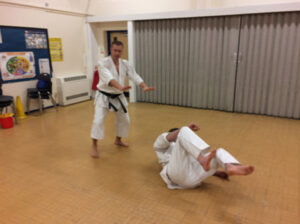What Zanshin to use?
 The purpose of this short article is to stimulate a discussion or provoke thought into how, why, and for what context you practice Zanshin…..
The purpose of this short article is to stimulate a discussion or provoke thought into how, why, and for what context you practice Zanshin…..
I recently had a conversation with a good friend who runs a successful karate dojo with many National and International Karate competitors. I was telling my friend about our training practice of a 360 scan following taking a threat to the floor. This means once we have taken the threat to the floor with striking and the immediate danger is over, we back away with hands up in a non aggressive manner scanning the area 360 degree for other threats (his mates), exits, etc…The 360 scan can also begin while taking the threat down. Using one hand to datum set and locate the head to strike, while visually looking for other threats, exits, etc.
What I found interesting was my friend said if in a competition they looked away while striking or taking an opponent down. They would not be awarded the point. Because it would be deemed a lack of “Zanshin” or awareness, “You have to focus on the opponent” he said! The two photos show the difference between focusing on one opponent and escaping a threat for SD.
Once again the discussion comes down to Context. Two very different objectives – Sport karate & Self defence karate (SD). What I found interesting and potentially dangerous was. Are karate students training in a sport or Do method. Building a trained response to actually ignore potential danger, if they unfortunately need their physical skill outside the dojo?
For SD, of course we need to focus on the immediate threat. But it is equally important to be aware of other threats around us. One popular way of training this, is to always assume there is more than one. Even if we are training a one on one situation, we assume there is more than one. This way we condition the habit not to solely obsess on one person.
In a real life situation along with the many other effects of adrenaline. It is very likely to experience tunnel vision. In our dojo we often use plastic glasses with blackout tape covering the sides, we call these tunnel vision glasses.
By using these glasses we simulate the effects of tunnel vision, which requires us to turn the head and body to see all around for threats or exits etc. It is easy to get into the habit of relying on your peripheral vision in a controlled dojo environment.
Whether standing or taking the threat to the floor, we encourage using datum setting. This is one hand holding the head or placed on the head to locate it and strike with the other hand, elbow, etc. By using proprioception, we can now look for other threats and still strike the immediate threat in our control.
Essentially we do not even need to look at the threat to strike accurately and effectively. To me this is what I mean when I tell a student “be aware of your surroundings” or Zanshin in Japanese. For SD we do not fixated on one threat, our awareness must be all around.
I studied mainstream Shotokan for 27 years before moving to a Self Defence, pragmatic approach. Never in that time was I taught or encourage to look for other threats. There may have been “lip service” given by way of “look for other opponents”. But no actual training methods were practiced. It was always a consensual one on one fight (spar). Many times Zanshin was mentioned but never or seldom was the attention focused on more than one person or one single point.
I would like to suggest those who do not already practice this. For the context of SD, practice the many methods of physically looking (360 scan) for other threats, exits, etc. It is no good just giving it lip service, these methods must be practiced. Add to your sport or Do single focus attention.
Be aware of the different context Zanshin can be useful for. It may keep you out of hospital.

